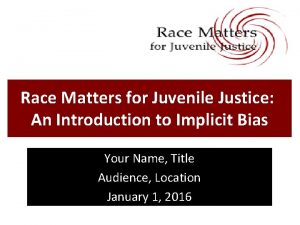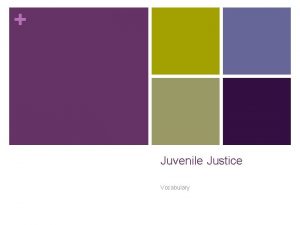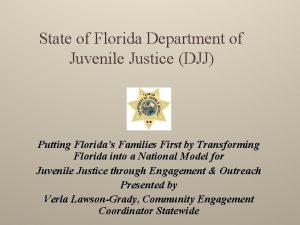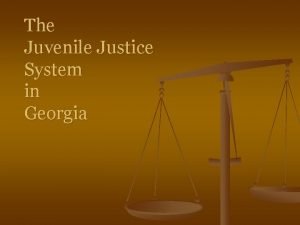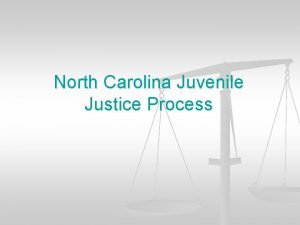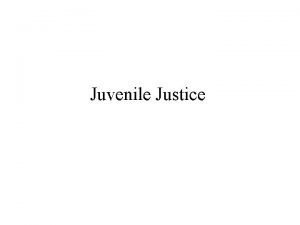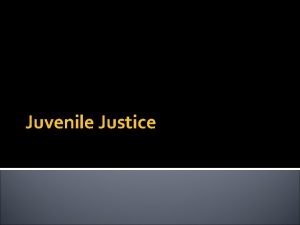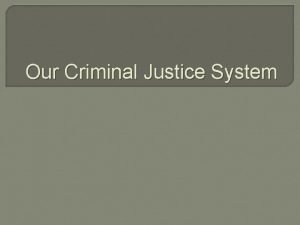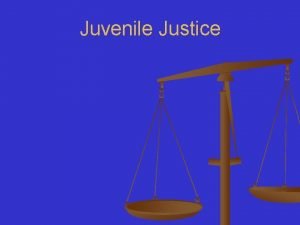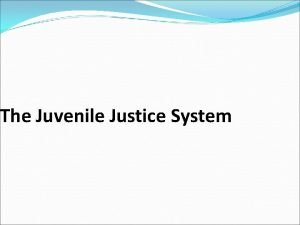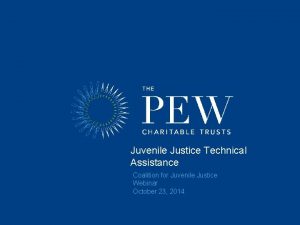Juvenile Justice How has treatment of young criminal








- Slides: 8

Juvenile Justice How has treatment of young criminal offenders changed?

Beginnings of a Juvenile Justice System In the mid– 1800 s, some people began to believe that family failure was the reason juveniles committed crimes. • said that the parents of these children had failed to teach them proper values. • first juvenile court - Cook County (Chicago), Illinois, in 1899. rehabilitate, or correct, a young offender’s behavior. • However, they also had strong feelings that children should be punished for crimes. • debate over these two aims of the juvenile justice system continues today.

Changes to the System By the 1960 s, many people thought the juvenile justice system needed to be changed. • thought too much emphasis, or weight, was placed on punishment. • In some cases, children were treated more harshly than adults who committed the same crime. In a series of decisions, the U. S. Supreme Court ruled that children have some of the same legal rights that adults have: • • the the right to to be told of the charges against them an attorney cross-examine witnesses against them remain silent when being questioned The Court also ruled that “guilty beyond a reasonable doubt”— the standard in adult cases—should apply to juvenile cases too. • By the 1990 s, Juvenile crime rates were rising rapidly. • As a result, state legislatures passed laws requiring harsher penalties for both juveniles and adults.

Juvenile Justice Today Every state has its own special set of laws for handling juvenile delinquents —the name given to young people who commit crimes. • Most states consider anyone under age 18 to be a juvenile. (some states age as low as 16)

Juvenile Offenders two types 1. Delinquent offenders are young people who have committed acts that would be crimes if committed by adults. 2. Status offenders are those who have committed acts that would not be crimes if done by adults. • Such offenses include running away from home or skipping school. • Status offenders are considered beyond the control of their parents or guardians. • For this reason, the court will supervise them.

The Juvenile Court System What procedures are followed when a young person breaks the law? Juvenile courts handle two types of cases— 1. neglect - Cases of neglect involve young people whose caregivers abuse them or fail to care for them. • A juvenile court has the power to remove these children from their homes and place them with other families. 2. delinquency- Delinquency cases involve juveniles who commit crimes. • The process of handling these cases is generally the same, though in each state it may differ in detail.

The Intake Process custody is to take charge of someone in an official way. Diversion- This means that the youth will receive counseling, drug treatment, or other services but will not go to court.

The Hearing Process Those who remain in the system after intake face up to three hearings. 1. detention hearing is like the preliminary hearing for adults. The state must show that there is good reason to believe the youth committed the crime. 2. adjudication hearing is like an adult trial. • closed to the public and usually does not include a jury. • At this hearing, the attorney for the youth presents evidence, calls witnesses, and cross–examines witnesses for the state. • At the end, the judge finds the youth to be innocent or “delinquent. ” That is like a guilty verdict. 3. Delinquent youths face a disposition hearing. • This is like the sentencing hearing for adults. • judge may give the youth probation – (Certain restrictions to follow) - If the youth completes that time with no more trouble, the charges will be dropped and removed from his or her record. • If the crime was serious, the youth may be sent to an institution for young offenders. • Most delinquents who are sent to an institution serve from one to three years. In some states, they can be held until age 18 or 21.

